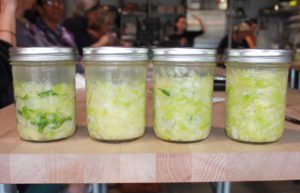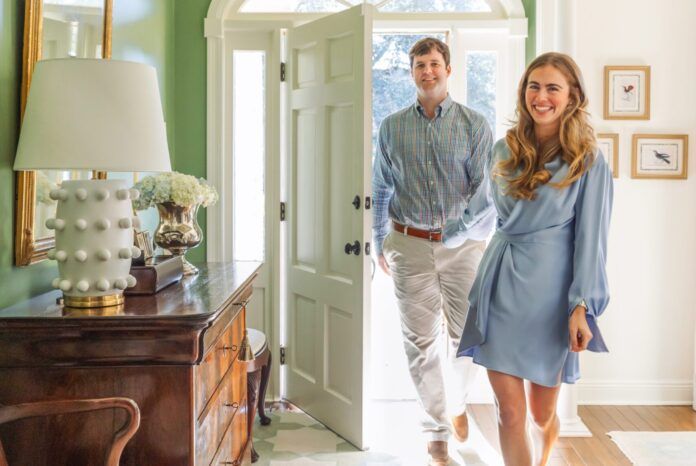We made our own probiotic-happy sauerkraut at Red Stick Spice
When I picture a cooking class, I imagine a room packed full of aspiring chefs in white aprons. They are all intently chopping, stirring and measuring while a Gordon Ramsay-like instructor paces, closely inspecting each dish with each pass. As a total stranger to the kitchen, I walked into Red Stick Spice Company for a sauerkraut-making class and wondered if this is the type of environment I should expect.
 I sat down at a station and saw two ingredients in front of me—Himalayan pink sea salt and a full head of cabbage. As I scanned the instruction sheet, the other participants filled the room, and our instructor Kaitlynn Fenley—who we featured along with her business, Cultured Guru, in our March issue—told us her story. She explained the importance of good microbes and how fermented veggies are full of probiotics and promote a healthy gut. After her presentation, the actual “cooking” began with chopping our cabbages.
I sat down at a station and saw two ingredients in front of me—Himalayan pink sea salt and a full head of cabbage. As I scanned the instruction sheet, the other participants filled the room, and our instructor Kaitlynn Fenley—who we featured along with her business, Cultured Guru, in our March issue—told us her story. She explained the importance of good microbes and how fermented veggies are full of probiotics and promote a healthy gut. After her presentation, the actual “cooking” began with chopping our cabbages.
I looked to my left and watched the women next to me shred their cabbages into thin slivers with such ease. I tried to make eye contact with one the cooking assistants because I had no idea where to begin.
“Honey, you should’ve taken the knife skills class before this,” the woman I was sharing a station with laughed. “Here, watch me, and hold your knife like this.”
 Altering my grip on the knife helped speed up my chopping a little bit, but I was still left with chunks of cabbage, rather than shreds. Next, we weighed our cabbage in grams to determine how much salt to add. After a bit of math, we began mixing our appropriate amounts of salt into our cabbage.
Altering my grip on the knife helped speed up my chopping a little bit, but I was still left with chunks of cabbage, rather than shreds. Next, we weighed our cabbage in grams to determine how much salt to add. After a bit of math, we began mixing our appropriate amounts of salt into our cabbage.
The more I mixed, the wetter the cabbage became until a puddle appeared at the bottom of my bowl. We had to wring out our cabbage like a dishrag to draw out the water, creating brine. After tightly packing the wet cabbage into a mason jar, we poured in the brine and placed a fermentation weight on top. Kaitlynn stressed that as long as the weight stayed “below the brine, its fine”, meaning our cabbage needed to remain completely submerged.
 She wrapped up the class with a presentation explaining how to care for our sauerkraut. She described certain colors to look for and how to “burp” our mason jars. We also got to enjoy delicious grilled ham and cheese sandwiches, with sauerkraut on them, of course.
She wrapped up the class with a presentation explaining how to care for our sauerkraut. She described certain colors to look for and how to “burp” our mason jars. We also got to enjoy delicious grilled ham and cheese sandwiches, with sauerkraut on them, of course.
Overall, my first cooking class was quite enjoyable, and I would love to try another. My station may have been the messiest because I managed to spill salt and cabbage all over the floor. But after three and a half weeks of fermentation, hopefully my finished product will be edible, despite my lack of culinary skills.
You can register for Kaitlynn’s sauerkraut making class, and others, at redstickspice.com. Check out her blog, Cultured Guru, for delicious recipes and to learn more about the science behind fermentation, and read our article on Baton Rouge’s fermented food trend in our March issue, available on newsstands now.












